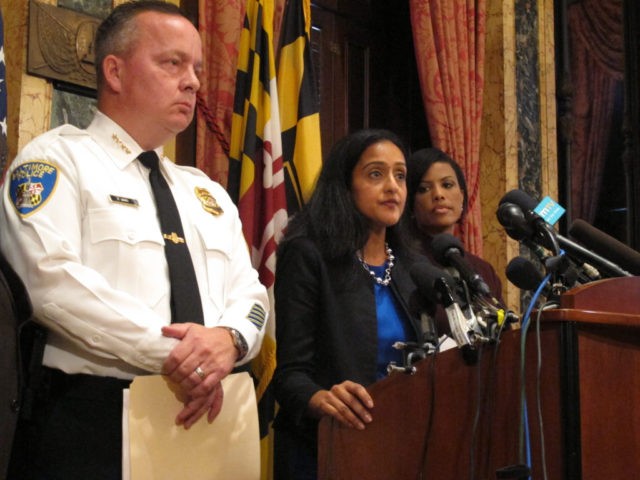BALTIMORE (AP) — The Justice Department and Baltimore police agreed to negotiate court-enforceable reforms after a scathing federal report released Wednesday criticized officers for using excessive force and routinely discriminating against blacks.
The report, the culmination of a yearlong investigation into one of the country’s largest police forces, found that officers make a large number of stops — mostly in poor, black neighborhoods — with dubious justification and unlawfully arrest citizens when officers “did not like what those individuals said.”
“These violations have deeply eroded the relationship between the police and community it serves,” Vanita Gupta, the head of the Justice Department’s civil rights division, said during a news conference alongside the city’s mayor and police commissioner.
The federal investigation was launched after the April 2015 death of Freddie Gray, a 25-year-old black man whose neck was broken while he was handcuffed and shackled but left unrestrained in the back of a police van. The death set off protests and the worst riots in decades.
The report represents a damning indictment of how the city’s police officers carry out the most fundamental of policing practices, including traffic stops and searches.
“It doesn’t matter, if you’re black you’re going to get stopped. It’s crazy out here,” said Anthony Williams, who is black. He was with his kids and once saw officers chasing a teenager for smoking weed. “There was five of them. They jumped on him. I had to tell my kids they were just playing.”
Donald Whitehead said officers would often jump out of the car and grab people “for no reason at all.”
“One day I was walking down the street to the store, and one of them jumped out on me and forced me to empty my pockets. They were looking for drugs. I don’t do drugs,” he said. “They just harass people.”
Police Commissioner Kevin Davis said six officers who committed egregious violations have been fired this year.
“Fighting crime and having a better, more respectful relationship with the community are not mutually exclusive endeavors. We don’t have to choose one or the other. We’re choosing both. It’s 2016,” Davis said.
The commissioner and Mayor Stephanie Rawlings-Blake promised the report would serve as a blueprint for sweeping changes.
The court-enforceable consent decree will force the police agency to commit to improving its procedures to avoid a lawsuit. The decree likely will not be finalized for many months, Gupta said.
The Justice Department has undertaken similar wide-reaching investigations into the police in Chicago, Cleveland, Albuquerque and Ferguson, Missouri, among other cities.
Federal investigators spent more than a year interviewing Baltimore residents, police officers, prosecutors, public defenders and elected officials, as well as riding along with officers on duty and reviewing documents and complaints.
“Nearly everyone who spoke to us … agreed the Baltimore Police Department needs sustainable reform,” Gupta said.
Among the findings: Black residents account for roughly 84 percent of stops, though they represent just 63 percent of the city’s population. Likewise, African-Americans make up 95 percent of the 410 people stopped at least 10 times by officers from 2010-15.
During the same time period, officers stopped 34 black residents 20 times, and seven African-Americans 30 times or more. No individuals of any other race were stopped more than 12 times.
One man who spoke to investigators said he was stopped 30 times in less than four years. At least 15 of those stops, he said, were to check for outstanding warrants. None of the stops resulted in charges.
In addition to pat-downs, Baltimore officers perform unconstitutional public strip searches, including searches of people who aren’t under arrest.
Officers routinely use unreasonable and excessive force, including against juveniles and citizens who aren’t dangerous or posing an immediate threat, the report said.
“BPD teaches officers to use aggressive tactics,” the report said. “BPD’s trainings fuel an ‘us vs. them’ mentality we saw some officers display toward community members, alienating the civilians they are meant to serve.”
The report partially blames the department’s unconstitutional practices on a “zero tolerance” policy dating back to the early 2000s, during which residents were arrested en masse for minor misdemeanor charges such as loitering.
Although the department has publicly denounced these practices after a 2010 settlement with the NAACP, which sued the department over the policing strategy, “the legacy of the zero tolerance era continues to influence officer activity and contribute to constitutional violations,” the report said.
Officers also routinely stop and question individuals without cause or a legitimate suspicion that they’re involved in criminal activity, the report says: No charges were filed in 26 of every 27 pedestrian stops. The directives often come from supervisors. In one instance, a supervisor told a subordinate officer to “make something up” after the officer protested an order to stop and question a group of young black men for no reason.
State’s Attorney Marilyn Mosby, the city’s top prosecutor, said she expected the report to “confirm what many in our city already know or have experienced firsthand.”
“While the vast majority of Baltimore City Police officers are good officers, we also know that there are bad officers and that the department has routinely failed to oversee, train, or hold bad actors accountable,” she said in a statement.
Six officers, three white and three black, were charged in the death of Gray. Three were acquitted, another officer’s trial ended in a mistrial and the charges against the others were dropped.
___
Associated Press writers Brian Witte and Sarah Brumfield contributed to this report.

COMMENTS
Please let us know if you're having issues with commenting.